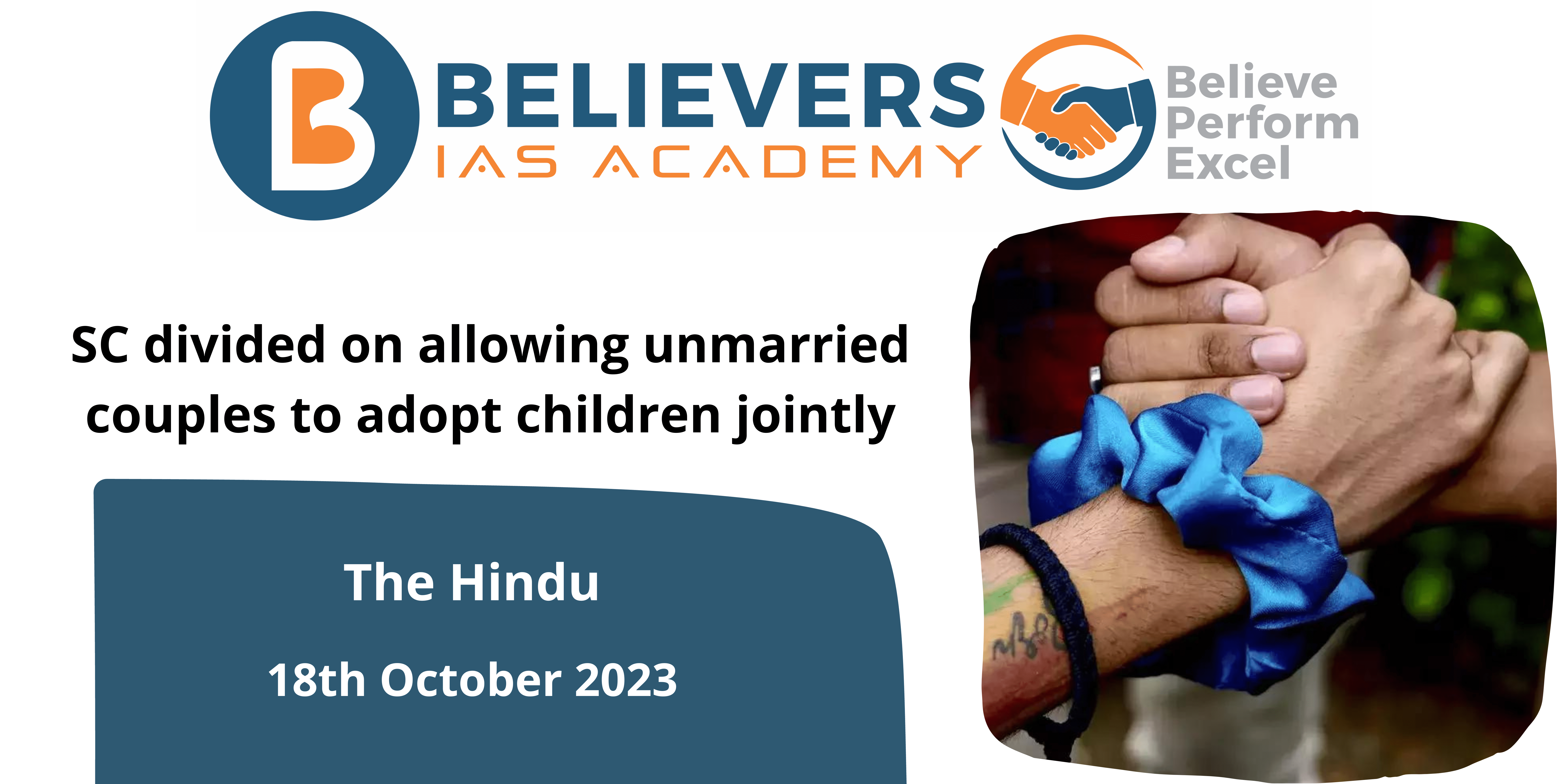SC divided on allowing unmarried couples to adopt children jointly
Context
Chief Justice D.Y. Chandrachud ruled that Regulation 5(3) of the Adoption Regulations, which prohibits unmarried partners from potentially becoming adoptive parents, violates the fundamental rights of homosexual couples and goes beyond the bounds of the Juvenile Justice (JJ) Act.
What was the judgment recently passed out?
On Tuesday, a Constitution Bench of the Supreme Court ruled that same-sex marriage recognition and regulation may only come from the legislative branch. The Bench reasoned that the courts could not get involved since there was no unqualified or fundamental right to marry.
Why are same-sex couples not able to adopt children as per the new judgment?
- Differing Opinions in a Legal Case: The Constitution Bench ruling that included contrasting views on the adoption rights of same-sex couples.
- Regulation 5(3) of Adoption Regulations: Regulation 5(3) of the Adoption Regulations is the subject of controversy. This law forbids unmarried partners—including couples of the same sex—from applying to be potential adoptive parents.
What is the regulation 5(3) of the Adoption Regulations?
- A child cannot be placed for adoption with a couple unless they have maintained a steady marital relationship for at least two years, according to Regulation 5(3) of the Adoption Regulations. The adoption of a stepparent or relative is an exception to this norm.
- The requirements for potential adoptive parents’ eligibility are covered in Section 5 of the Adoption Regulations. This comprises:
- Their capacity on a mental, emotional, physical, and financial level
- Their criminal histories or abuse records
What are the other eligibility criteria followed in India?
- Someone under 25 can’t adopt a child.
- The adopted child and the adoptive parents must be at least 25 years apart in age.
- To adopt a kid, a married couple have to be together for at least two years.
- Couples that are married must be between the ages of 33 and 55.
- The aggregate age of married spouses cannot be more than 110 years.
- There can be no more than three children living in the home of a married couple.
What are the possible concerns that a child may face in same-sex marriage?
- Legal and Financial Rights: Certain legal and financial rights and benefits that are normally granted to children of married couples may be difficult for adopted children of single or same-sex couples to obtain. This covers tax implications, insurance benefits, and inheritance rights.
- Social Stigma: Because adopted children come from a different family structure than the traditional nuclear family, they may face prejudice or social stigma. Peers, teachers, and community members may show them prejudice or bigotry.
- The psychological health of the child: The psychological health of adopted children in non-traditional family settings has drawn some criticism. Despite the lack of solid proof, critics contend that children learn best in a stable, traditional home setting.
- Educational and Social Support: Since these programs are frequently created with the presumption of a married, two-parent household, children in non-matrimonial homes may find it difficult to access them.
- Legal Protections and Custody: Since family law in many areas is still oriented toward traditional marriage, children in non-traditional families may face particular legal challenges regarding custody and visitation rights in the event of a split or conflict within the family.
What is the way forward?
- Examine and Modify Regulations: To end discrimination based on sexual orientation or marital status, governments should examine and, if required, modify adoption regulations. Make sure the adoption procedure is equitable and inclusive.
- Encourage Diversity: Spread the word about the value of inclusivity in adoption and debunk any myths or prejudices regarding same-sex and single families’ capacity to give adopted children a stable and loving home.
- Educate the Parties: Provide educational programs to enable the public, legal professionals, social workers, and adoption agencies to better understand the rights and needs of children raised in non-traditional households.
- Family Support Services: Help single parents and same-sex couples navigate the adoption process and give adopted children a secure, loving home by offering support services to families.
- Enforce Anti-Discrimination Laws: To safeguard the rights of kids and parents in non-traditional families, anti-discrimination laws should be strengthened.
- Take Action Against Bullying: Establish anti-bullying initiatives in schools to provide inclusive, safe spaces for all kids, irrespective of their family setup.
Conclusion
The solution is to build a society that celebrates variety and makes sure all kids grow up in caring, supporting homes regardless of their parent’s sexual orientation or marital status. The needs and rights of all children and families, including those in non-traditional family arrangements, can be better met by society by removing legal obstacles, fostering inclusion, and offering the required support.




